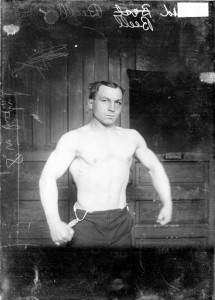Tseeb Brawl los yog Pre-Match Hype?
Qhov kawg ntawm 1905, Fred Beell yog mus txawv tebchaws America hyping tuaj ib match nrog tus American Heavyweight Wrestling Champion Tom Jenkins. Beell yog ib tus American Heavyweight Wrestling Champion muaj swb Frank Gotch hauv ib “ua haujlwm” Match nyob New Orleans thaum hlis ntuj nqeg 1903. Nws poob lub npe rov qab mus Gotch ob peb lub lis piam tom qab.
Muaj peev xwm wrestlers, Jenkins and Beell both wrestled in “tua” thiab “ua haujlwm” ntais ntawv. The up-coming match would be a “tua” or legitimate contest because Jenkins’ matches were primarily “yub”.

Fred Beell posing rau lub koob yees duab hauv lub xyoo pua Twentieth xyoo pua ntawm pej xeem Domain
While equal in skill, Beell was at a size disadvantage as usual. Beell stood 5’06” and weighted a powerful 165 phaus. Txawm li cas los, Jenkins was three inches taller and 30 cev ntas phaus. Jenkins had also beaten Frank Gotch in a “tua” contest. He was the last wrestler to hold a legitimate win over Gotch.
To build anticipation for the match and Beell as a legitimate contender for Jenkins, Beell started touring the major cities. The wrestling tour was a common tactic to generate interest in the major newspapers, the mass media of the early 20th Century.
Beell wrestled a local Cleveland man named Davis on Friday, Cuaj hlis 15, 1905. Beell roughly handled the inexperienced wrestler to build himself up as the villain or “heel” in the upcoming match with Jenkins. Txawm li cas los, his tactics caused the crowd to become enraged.
While newspaper reporters were frequently skeptical of the legitimacy of the wrestling matches, the fans either believed what they saw or wanted to. The fans would often get so caught up in the matches that an unfavorable decision, controversy or loss by the local favorite could result in a riot.
After Beell won, the crowd began to boo and hiss. As the crowd moved menacingly towards the stage, Mark Lamb, who discovered Tom Jenkins and helped train him, walked onto the stage from one of the wings. Lamb punched Beell’s manager Parker. The fisticuffs brought the fans towards the stage in a wave.
Doc Payne, the trainer of the Cleveland Indians, ran onto the stage to help his friend Parker. He threw a couple punches at Lamb. Lamb was unfazed and “sent Payne down for the count.”
As the crowd started to storm the stage, the Cleveland Police interceded and pushed the crowd back. The timely intervention of the police allowed Beell and Parker to make it backstage, while the police dispersed the crowd after 10 los sis 15 feeb.
The crowd wasn’t done though and gathered around the stage door outside the building. They began kicking the door down in an attempt to get there hands on Beell and Parker. A dozen police officers showed up at the stage door to protect the wrestlers. As the fans backed away, the policemen escorted Beell and Parker to their hotel.
The fight on stage might have been an attempt by Lamb and Parker to increase interest in the Beell vs. Jenkins match. If it was pre-match hype, it was successful. Newspapers across the country carried the story of the post-match fight. Txawm li cas los, they almost got themselves killed in the process. Riots would continue to be a risk in professional wrestling until Vince McMahon exposed the business in the 1990s.
Koj yuav tawm ib saib los nug cov lus nug txog qhov no los yog tej tsev xa rau kuv Facebook phab.
Tau qhov twg los: Waterbury Evening Democrat (Waterbury, Connecticut), Cuaj hlis 19, 1905 ib tsab, p. 9
Pin It
